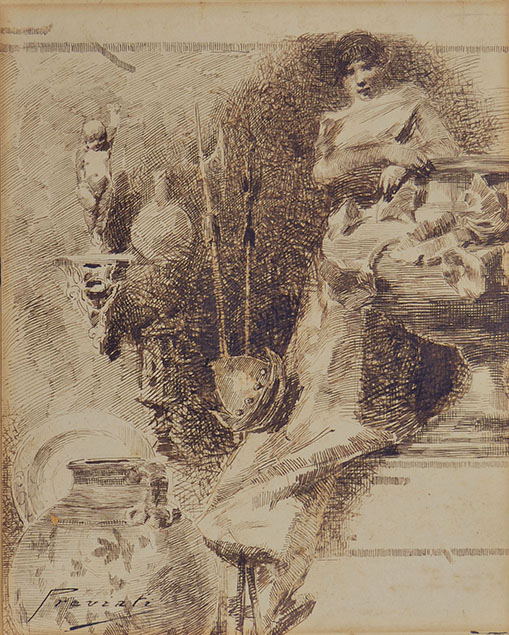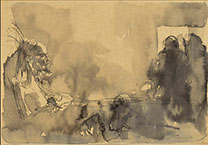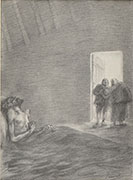(Ferrara 1852 - Lavagna 1920)
FIGURE OF A STANDING WOMAN AMONG OBJECTS, C. 1880
Pen and brown ink. Signed Previati bottom left. 283 x 228 mm
In the catalog of the 1999 Milanese exhibition, Fernando Mazzocca proposed to date this drawing c. 1800, considering it a work intended for collecting or an illustration for publishing.
LITERATURE
F. Mazzocca, Gaetano Previati, 1852-1920 : un protagonista del simbolismo europeo. Milan 1999; cat. No. 64a, illustrated.
Born into a pious family in Ferrara, Previati was predisposed toward the spiritual in art. He first enrolled in the Ferrarese academy in 1870. In 1876, he was in Florence where he studied with Cassioli, and the following year he was in Milan where he took courses at the Brera from Bertini. At first, Previati painted historical subjects in a romantic but naturalistic style. Later, under the influence of Morelli, Cremona and the Scapigliati, he developed a freer, more personal style characterized by a patterned impasto and dramatic light. He also studied the works of Rossetti and other Pre-Raphaelites and created overtly spiritual subjects. In the 1880s, Previati designed fourteen illustrations inspired by the writings of Edgar Allan Poe, a project that brought him in contact with Symbolism, and he was influenced by Félicien Rops, Gustave Moreau and Redon as well as writers of the movement. Around 1889, Previati met Vittore Grubicy who served as a catalyst in the artist’s adoption of Divisionism. Alberto Grubicy, Vittore’s brother, held a contract to sell Previati’s work as well as that of Segantini. In 1891, Previati exhibited 'Motherhood' at the Brera 'Triennale', now famous as the first Italian Symbolist exhibition and as the exhibition which introduced Divisionism. A year later, in 1892, Previati exhibited in Paris at Durand-Ruel through his association with Joseph Péladan’s Rose-Croix. Previati was an intellectual who believed that the world was entering a new age and that he needed to prepare other artists. To that end he wrote several books on theory and technique of painting.


